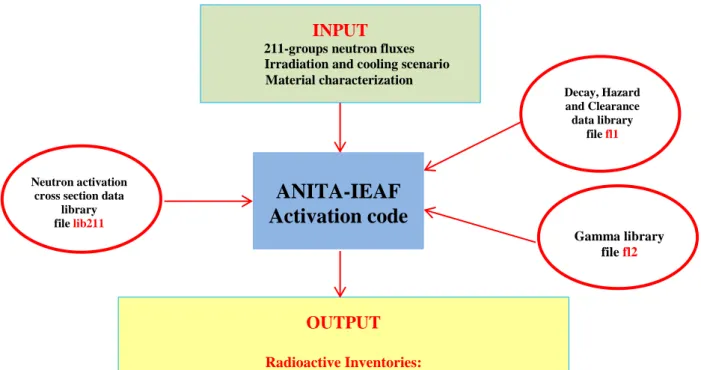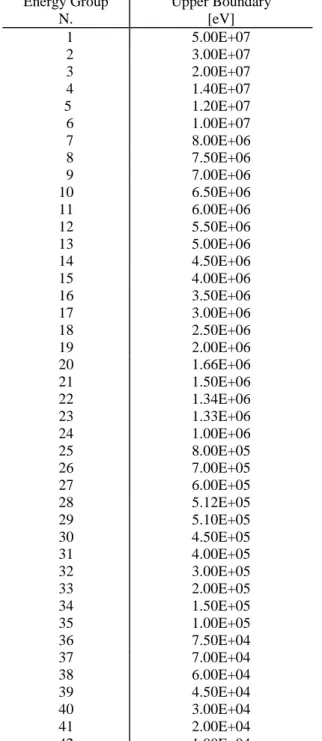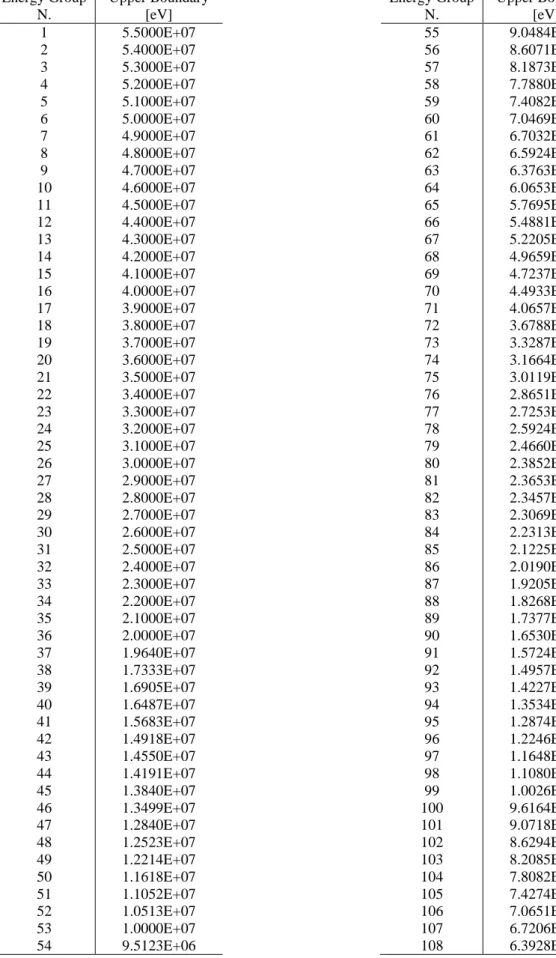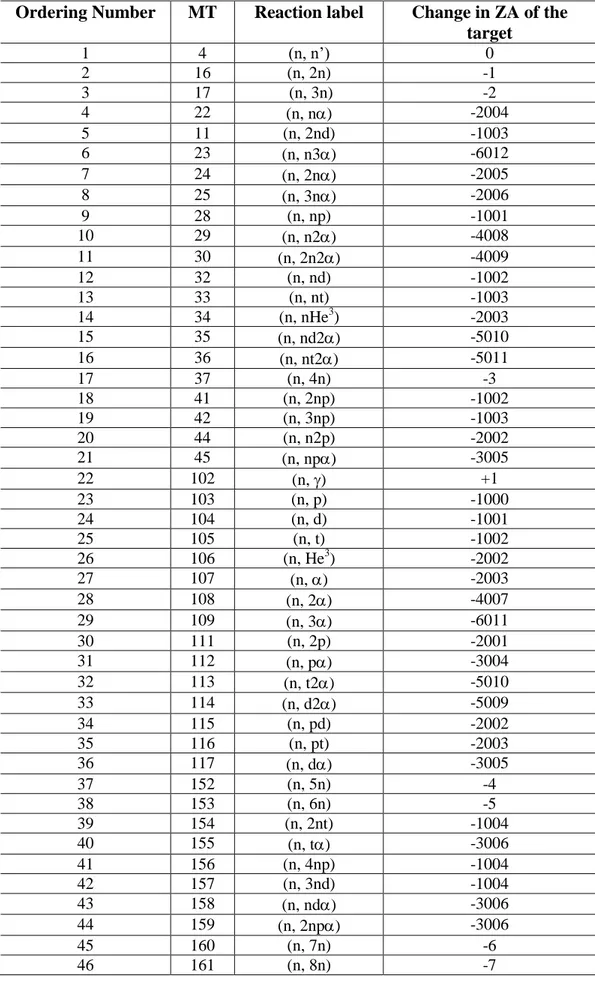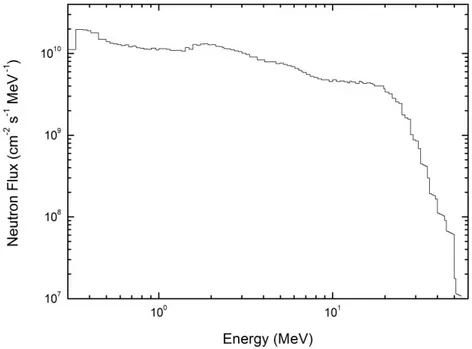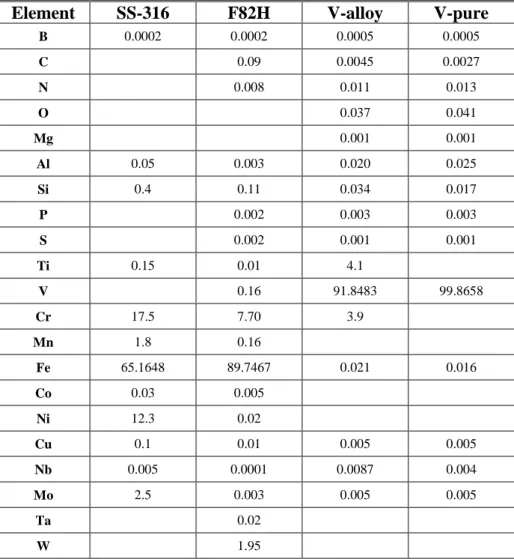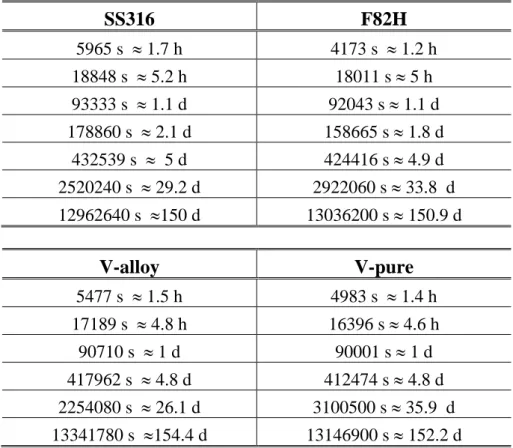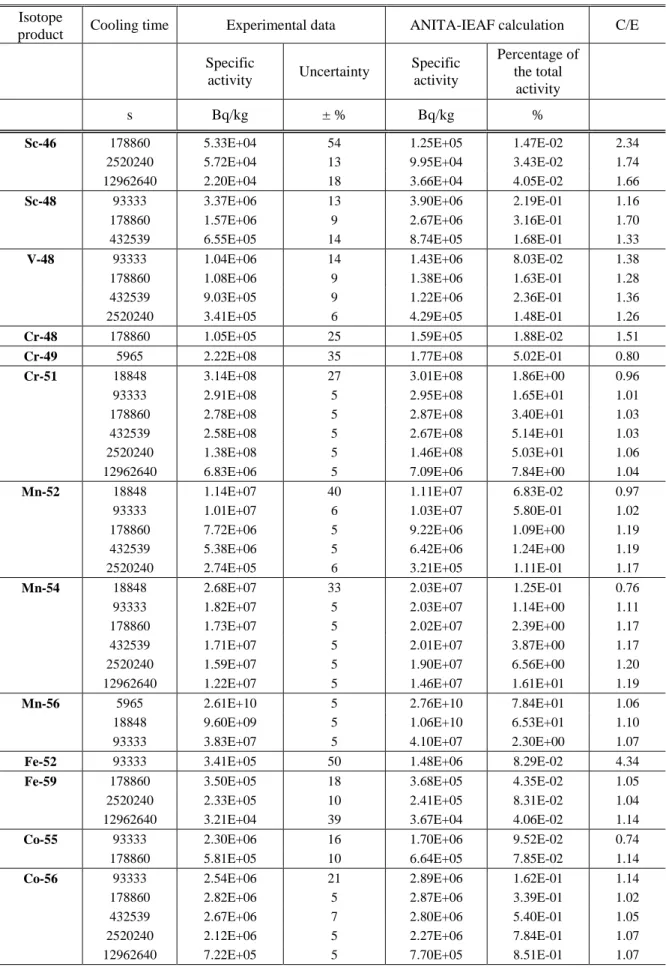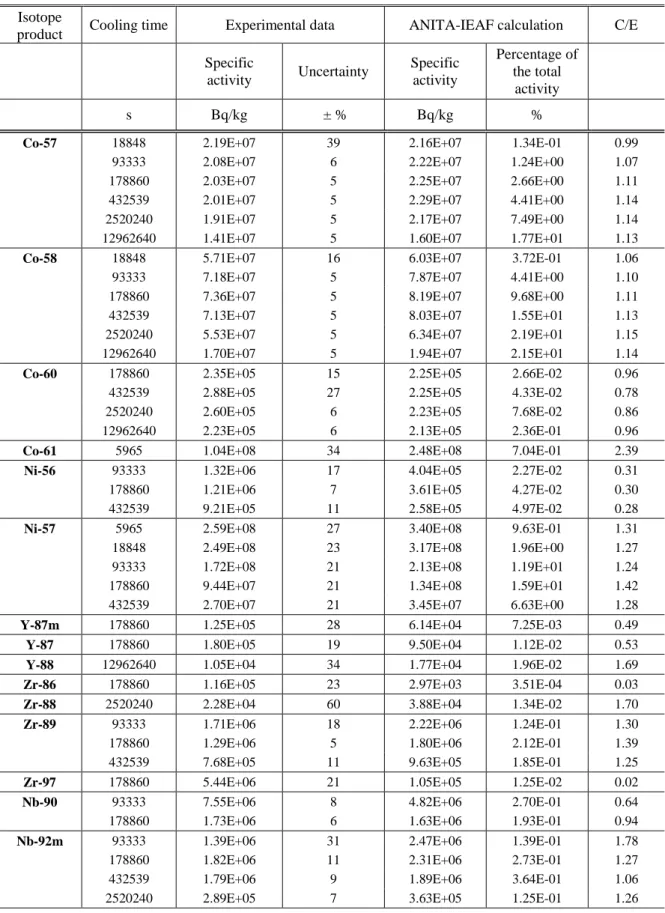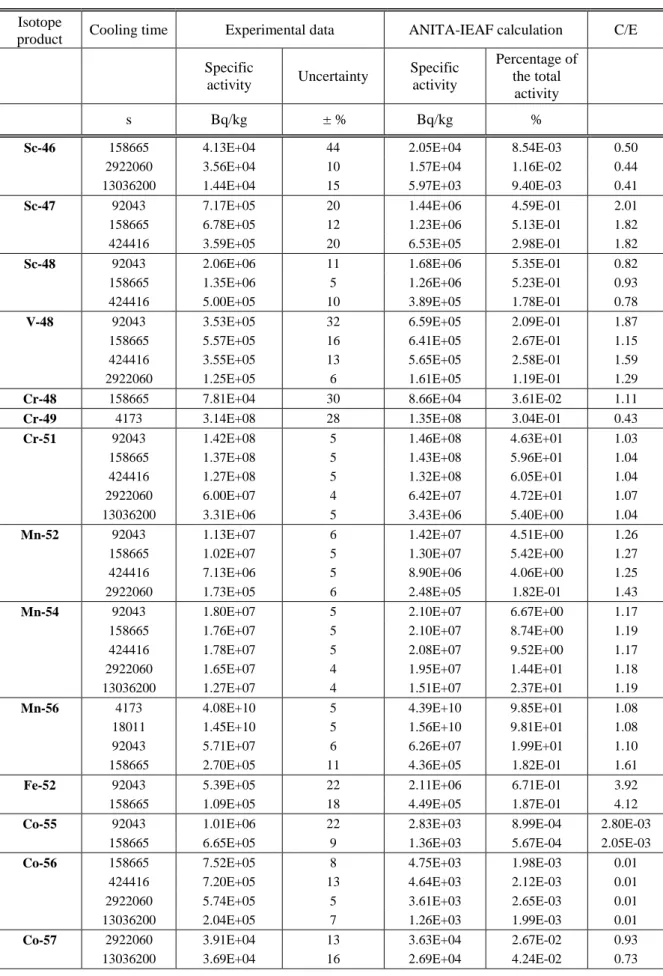Ricerca Sistema Elettrico ADPFISS-LP1-089
5
0 L 2 67
CONTENTS
1 INTRODUCTION ... 5
2 ANITA-IEAF ACTIVATION CODE ... 7
2.1 Main features of the activation code ... 7
2.2 Analytical Method... 7
3 DATA LIBRARIES ... 9
3.1 Decay, Hazard and Clearance Data library (file “fl1”) ... 10
3.1.1 Decay data ... 10
3.1.2 Hazard data ... 11
3.1.3 Clearance level data ... 11
3.1.4 Nuclide and Material Clearance Indexes ... 11
3.1.5 Structure of the “fl1” file ... 12
3.2 Gamma Library (file “fl2”) ... 15
3.3 Neutron activation cross section data library (file “lib211”) ... 18
4 HOW TO USE ... 23
4.1 Input/Output Unit-Files Assignments ... 23
4.2 Neutron Fluxes ... 24
4.3 Input Specifications... 27
4.4 Output Specifications ... 30
4.4.1 Standard Output ... 30
4.4.2 General Inventory Output Data File ... 33
4.4.3 Clearance Index Inventory Output Data File ... 33
4.4.4 Decay gamma sources Output Data File ... 34
4.5 How to run ANITA-IEAF ... 35
4.6 Sample Problems... 36
4.6.1 Test3 case input ... 36
4.6.2 Test3 case output ... 38
5 ANITA-IEAF VALIDATION... 48
5.1 Neutron Flux ... 48
5.2 Activation parameters ... 49
5.3 Samples compositions ... 49
5.4 Cooling times ... 50
5.5 Calculated and experimental results comparison ... 51
5.6 Results analysis ... 63
Ricerca Sistema Elettrico ADPFISS-LP1-089
5
0 L 3 67
FIGURE LIST
Figure 1 – ANITA-IEAF activation code block diagram ... 9
Figure 2 – Neutron flux ... 48
Figure 3 – SS-316 specific activity: calculation to experiment ratios (C/E). Main isotope contributors. ... 59
Figure 4 – SS-316 specific activity: calculation to experiment ratios (C/E). Other isotopes. ... 59
Figure 5 – F82H specific activity: calculation to experiment ratios (C/E). Main isotope contributors. ... 60
Figure 6 – F82H specific activity: calculation to experiment ratios (C/E). Other isotopes. ... 60
Figure 7 – V-alloy specific activity: calculation to experiment ratios (C/E). Main isotope contributors. ... 61
Figure 8 – V-alloy specific activity: calculation to experiment ratios (C/E). Other isotopes. ... 61
Ricerca Sistema Elettrico ADPFISS-LP1-089
5
0 L 4 67
TABLE LIST
Table 1 – Decay processes... 13
Table 2 – Upper boundaries of the Vitamin-J 42- energy group structure ... 15
Table 3 – Energy group boundaries of the Vitamin-J +(211-neutron energy group structure) ... 19
Table 4 – List of MT numbers used in ANITA-IEAF package ... 21
Table 5 – Activation parameters ... 49
Table 6 – Composition of samples in weight% ... 49
Table 7 – Cooling times ... 50
Table 8 – SS-316 specific activity- Experimental and calculated results ... 52
Table 9 – F82H specific activity- Experimental and calculated results ... 55
Table 10 – V-alloy specific activity- Experimental and calculated results ... 57
Ricerca Sistema Elettrico ADPFISS-LP1-089
5
0 L 5 67
ANITA-IEAF
an intermediate energy neutron activation system
Manuela Frisoni November 2017
1 INTRODUCTION
ANITA-IEAF is a package (code and libraries) developed in ENEA-Bologna able to assess the activation of materials exposed to neutrons with energies up to 55 MeV. (The identification IEAF results from the first ANITA-IEAF version [1] that used the activation cross section library based on the Intermediate Energy Activation File IEAF-2001 [2]). It is an updating/extension of the ANITA-2000 code package freely distributed at OECD-NEADB [3] and ORNL-RSICC [4] , able to handle neutron energies up to 20 MeV, widely used and validated in the past by ENEA [5][6][7][8][9][10] .
The ANITA-IEAF package is needed in order to perform neutron activation calculations for some plants as the International Fusion Materials Irradiation Facility (IFMIF) and, more recently, the DEMO Oriented Neutron Source (DONES), that have been proposed as neutron sources to test samples of candidate materials to be used in future fusion power plants. In both these facilities the neutron source is produced through the reaction of 40 MeV deuterons impinging on a liquid lithium target and a considerable amount of neutrons with energies above 20 MeV is produced. The availability of reliable nuclear data and activation codes in the neutron energy range extended over 20 MeV is required in order to perform activation calculations for these devices.
The main component of the ANITA-IEAF package is the activation code ANITA-IEAF that computes the radioactive inventory of a material exposed to neutron irradiation, continuous or stepwise. It traces back to the ANITA code (Analysis of Neutron Induced Transmutation and Activation) [11]. The ANITA-IEAF code provides activity, atomic density, decay heat, biological hazard, clearance index and decay gamma-ray sources versus cooling time. Results are given as for each nuclide as for the material.
The ANITA-IEAF code package is provided with a complete data base allowing to perform calculations for all the elements with the atomic number up to 94. The libraries contained in the code package are:
1) Neutron activation data library (file “eaf2010_lib”), containing the neutron induced cross sections on target nuclides.
Ricerca Sistema Elettrico ADPFISS-LP1-089
5
0 L 6 67
2) Decay, Hazard and Clearance data library (file “fl1”), containing the quantities describing the decay properties of unstable nuclides.
3) Gamma library (file “fl2”), containing the gamma ray spectra emitted by the radioactive nuclei.
The neutron activation cross section data library is based on the EAF-2010 [12] group-wise neutron activation cross section library “eaf_n_gxs_211_flt_20010” in the VITAMIN-J+ (211 energy group structure) up to 55 MeV, contained in the EASY-2010 code package [13].
The data contained in the fl1 and fl2 files are based on the JEFF-3.1.1 Radioactive Decay Data Library [14].
Three test cases (both input and output files) are included in the code package.
In this report the characteristics of the libraries contained in the package, the input data specification and the output description, with reference to a representative sample problem, are given.
The validation effort related to the comparison between the code predictions and the activity measurements obtained from the Karlsruhe Isochronous Cyclotron is also presented.
Ricerca Sistema Elettrico ADPFISS-LP1-089
5
0 L 7 67
2 ANITA-IEAF ACTIVATION CODE
2.1
Main features of the activation codeThe ANITA-IEAF activation code included in the package computes the radioactive inventory of a material exposed to neutron irradiation, continuous or stepwise. The ANITA-IEAF code provides activity, atomic density, decay heat, biological hazard, clearance index and decay gamma-ray source spectra at shutdown and at different cooling times. It treats all the elements with the atomic number up to 94.
The analytical computational method used by ANITA-IEAF is highly performing as far as the computer time is concerned.
2.2
Analytical MethodThe calculation method [15] used by the code is summarized in the following.
The neutron irradiation of an atomic species A(N,Z) gives rise to several possible nuclear reactions whose number increases with increasing the energy of the incident particles. The new atomic species produced by the neutron-induced reactions may be stable or unstable or may be produced in the ground or a metastable state. Unstable nuclei will sooner or later decay into a new state or into a new species of nuclei, which in turn could be stable or decay again. These processes give rise to a decay chain that will end when a stable state is reached.
The time dependence of the concentration of a given nuclide Ni obeys the following balance
equation:
dN
dt Formation Rate - Destruction Rate - Decay Rate
i (1)
The ANITA-IEAF code considers radioactive disintegration and neutron induced reactions as the processes appearing on the right-hand side of the Eq. (1). The time rate of change of the concentration for a particular nuclide Ni , in terms of these phenomena, can be written as:
dN
dt N N N N
i
r,i-1 i-1 i i r,i i i
' '
i (2)
where (i= 1....I), and
r,i-1 Ni-1 is the transmutation rate into Ni due to the neutron induced reaction r on the
Ricerca Sistema Elettrico ADPFISS-LP1-089
5
0 L 8 67
i Ni is the rate of formation of Ni due to the radioactive decay of nuclides Ni,
r,i Ni is the destruction rate of Ni due to all possible neutron induced reactions (n, ; n, ; n,p ; n,2n ; n,np ; etc.), and
i Ni is the radioactive decay rate of Ni
Considering all the I nuclidesof the chain, the Eq. (2) represents a coupled set of homogenous first order linear differential equations with constant coefficients. The ANITA-IEAF code solves this set of equations by the analytical matrix exponential method.
The Eq. (2) can be written in matrix notation as
d˜ N dt A ˜ N (3)
where Ñ is the vector of nuclide concentrations and A
is the transition matrix containing the rate coefficients for radioactive decay and neutron absorption. Eq. (3) has the known solution
N (t) = ˜ ˜ N (0)eA
t (4)
where N(0)~ is the vector of initial nuclide concentrations. The Eq. (4) can be expanded as
˜ N (t) = ˜ N (0) (A t)m m! m= 0
(5)The Eq. (5) yields a complete solution to the problem. The irradiation is assumed to start at time zero when N1(0) is known and Ni (0) = 0 for i > 1. By defining these initial conditions the solutions
of the system of Eq. (2) can be calculated by recurrence relations quite suitable for computer programming.
The particular cases when the decay time of an unstable nucleus of the chain is much longer or shorter than the irradiation time interval are taken into account and treated separately. The Eq. (2) holds during the irradiation time. At the end of this time the Bateman equations are solved describing the naturally occurring radioactive decay chains with the densities, solutions of the system (Eq. 2) at the end of irradiation, as initial conditions. Continuous or multi-steps (up to 2000 burn-dwell intervals) can be considered for the operational scenario. A different level of the irradiation flux can be used for each one of the exposure time steps.
Ricerca Sistema Elettrico ADPFISS-LP1-089
5
0 L 9 67
3 DATA LIBRARIES
The ANITA-IEAF activation code requires the following data libraries:
Decay, Hazard and Clearance data library (file “fl1”)
Gamma library (file “fl2”)
Neutron activation cross section data library (file “lib211”)
The schematic block diagram of the data/libraries required by the ANITA-IEAF code is shown in Figure 1.
Figure 1 – ANITA-IEAF activation code block diagram
ANITA-IEAF
Activation code
INPUT
211-groups neutron fluxes Irradiation and cooling scenario Material characterization
OUTPUT
Radioactive Inventories:
activity, atomic density, decay heat, biological hazard, clearance index, decay gamma sources (42 groups) at shutdown and for various cooling times.
Results are given as for each nuclide as for the material
Gamma library file fl2
Neutron activation cross section data
library file lib211 Decay, Hazard and Clearance data library file fl1
Ricerca Sistema Elettrico ADPFISS-LP1-089
5
0 L 10 67
3.1 Decay, Hazard and Clearance Data library (file “fl1”)
This library contains the information describing the decay properties of unstable nuclides useful for the calculations performed by ANITA-IEAF.
For each nuclide, the decay data, as the decay mode, the decay constant (s-1), the total energy (MeV) released in the decay and the energy (MeV) released in the form of gamma or X-rays are provided. Different competitive decay modes are taken into account when contemporary.
The file contains also the hazard data (ALI) for each radionuclide describing its potential biological impact on human beings. The ALI quantities are defined as the Annual Limit of Intake (Bq) by ingestion or inhalation for the public or workers.
The library contains also the clearance level for each radionuclide.
The fl1 file contains data for 3433 nuclides. The description of the data contained in the file and their sources are described in the following.
3.1.1 Decay data
The decay data have been taken from the JEFF-3.1.1 Radioactive Decay Data library [14]. The standard library JEFF-3.1.1 is in ENDF-6 [16] format. The radioactive decay data are given in the section identified by MF=8, MT=457 (in ENDF-6 standard format notation). This section is restricted to single nuclides in their ground state or an isomeric state (a “long lived” excited state of the nucleus). The main purpose of MT=457 is to describe the energy spectra resulting from radioactive decay and give average parameters useful for applications such as decay heat and waste disposal studies, shielding, etc. For each isotope the following decay data are given: nuclide identification, half-life, number of decay modes, fractions of decay in each decay mode (branching ratio), energy released by the decay, gamma-ray intensity and energy spectrum in each decay mode. The standard library contains data for 3853 nuclei, ranging from the neutron (0-nn-1) to roentgenium 272 (111-Rg-272).
In the fl1 file the following basic decay data are included for each unstable nuclide:
- nuclide identification - decay mode
- decay constant
- total energy released in the decay (MeV) used to calculate decay heat
- energy released in the form of gamma or X-rays (MeV)
For the stable nuclides the isotopic abundances are given taken from Ref. [17]. The fl1 file contains data for the nuclei ranging from the 1-H-1 to 94-Pu-247.
Ricerca Sistema Elettrico ADPFISS-LP1-089
5
0 L 11 67
3.1.2 Hazard data
The ALI quantities were obtained from the “eaf_haz_20100” file contained in the EASY-2010 code package [18]. In the fl1 file used by the ANITA-IEAF code, the ALI values by ingestion for the public are given. A conversion factor of 0.001 (Sv/y) has been adopted to convert the dose coefficients from Ref. 18 to the ALI quantities. The ALI quantity is provided only for the 2006 nuclides contained in the “eaf_haz_20100” file.
3.1.3 Clearance level data
The fl1 file provides also for each radionuclide the clearance level CL (Bq/g). This value allows
to establish if a radioactive material can be potentially moved out of the originating facility and recycled.
The safe handling of radioactive waste is recognized as crucial to ensure protection of human health and the environment. IAEA publish regulations on these issues and reference [19] gives information on suggested clearance level values for a set of important radionuclides.
The clearance level data contained in the new fl1 file have been produced by including the information contained in [19].
The clearance levels for the 242 nuclides up to Pu-244 contained in Table 2 of Ref. [19] were included in the file fl1. The clearance level CL=10 has been attributed to 40K as suggested in Table 1
of Ref. [19].
Following the suggestion of Table 1 of Ref. [19], moreover, the clearance level CL=1 has been
attributed to radionuclides of natural origin. The list of the “Radioactive Nuclides in Nature” has been taken from [17].
For any other nuclide the clearance level was calculated by using the following Eq. (6) taken from [20] :
C
L=min
1/(E
+ 0.1
xE
) ; ALI
inhaled/10
3; ALI
ingested/10
5
(6)The values of E and E in Eq. (6) have been taken from the JEFF-3.1.1 library [14].
The ALI quantities in Eq. (6) have been obtained from the “eaf_haz_20100” file of EASY-2010 [18]. The conversion factor of 0.020 (Sv/y) has been adopted to convert the dose coefficients from Ref. [18] to the ALI quantities.
3.1.4 Nuclide and Material Clearance Indexes
The Isotope Clearance Index (ICI) of a single nuclide is calculated in ANITA-IEAF as: (7)
C
C
Li i Index Clearance Isotope
Ricerca Sistema Elettrico ADPFISS-LP1-089
5
0 L 12 67
where Ciis the specific activity of the radionuclide “i” in the material and CLi is the clearance level for that radionuclide.
In Eq. (7) activities and clearance levels have units of Bq g-1.
When a material contains several nuclides, the equation given below, and suggested in [20], is used to evaluate in ANITA-EAF the Material Clearance Index (MCI) :
1
n i
i Li
Material Clearance Index
C
C
(8)If MCI ≤ 1 then it is possible to clear the material.
3.1.5 Structure of the “fl1” file
The structure of the fl1 file used by ANITA-IEAF is described in the following:
Card 1 NUCLIB,TITLIB (I10,15A4)
where: NUCLIB: number of nuclides (stable or unstable) contained in the file TITLIB : alphanumeric title
For each nuclide two cards are given:
Card 2a IDNUC, IDEC, 1, Q1,G1, 2, Q2, G2
(I7,1X,I2,E10.4,2F10.7,E10.4,2F10.7)
Card 2b IDNUC, IDEC, QT,ALI,CLEAR, SYMB
(I7,1X,I2,F10.7,2E10.2,1X,A11) where:
IDNUC identification of the nuclide= Z*10000 + A*10 + M Z= atomic number
A= mass number
M= 0,1,2 for the ground state, the first and the second metastable state,
respectively
IDEC identification of the decay type (see Table 1) 0< IDEC < 10 single decay
10 IDEC double decay
“blank” indicates stable isotopes; in this case “Q1” is the isotopic
abundance and , Q, G are zeroes;
Ricerca Sistema Elettrico ADPFISS-LP1-089
5
0 L 13 67
nuclei. Q1 in this case is their isotopic abundance and the
decay parameters are given as 2, Q2, G2.
1 decay constant (s-1)Q1 total energy (MeV) released in the decay (used to calculate the decay heat)
G1 energy released (MeV) in the form of X or rays
When a nuclide has two decay modes a second set of values 2, Q2, G2 is given. In this case the
decay constants 1 e2 were obtained by multiplying the decay constant for the branching-ratio of
each decay mode while Q2 e G2 are equal to Q1 e G1 .
When one of the two decay modes has a negligible probability only the dominant mode has been given with branching ratio BR= 1. When more than two decay modes are present only the two most important are considered in the library, with the BR normalised in order to have a total BR=1. These particular cases are outlined by a comment.
QTOT = Q1 (MeV)
ALI is the Annual Limit of Intake (Bq) by ingestion for the public CLEAR clearance level ( Bq/g)
SYMB alphanumeric symbol
IDEC Type of decay “Parent nucleus” “Daughter nuclei”
1 - A Z m A Z+1 0 2 +/EC A Z-1 0 3 IT1 A Z 0 4 A-4 Z-2 0 5 IT2 A Z m-1 10 - A Z+1 0 A Z+1 1 12 - and + A Z+1 0 A Z-1 0 13 - and IT A Z+1 0 A Z 0 20 + /EC A Z-1 0 A Z-1 1 23 + and IT A Z-1 0 A Z 0 Table 1 – Decay processes
Ricerca Sistema Elettrico ADPFISS-LP1-089
5
0 L 14 67
*JEFF-3.1.1 Decay&Hazard&Clearance Data |Card 1
……….…………. 270540 2 3.587E+00 4.4213428 1.0210000 |Card 2a 270540 2 4.4213428 6.67E+07 7.35E-01 27-CO- 54 |Card 2b 270541 2 7.806E-03 5.9777899 3.9305599 |Card 2a 270541 2 5.9777899 1.09E+05 2.42E-01 27-CO- 54M |Card 2b 270550 2 1.098E-05 2.4436109 2.0070300 |Card 2a 270550 2 2.4436109 1.00E+06 1.00E+01 27-CO- 55 |Card 2b 270560 2 1.038E-07 3.7138441 3.5916100 |Card 2a 270560 2 3.7138441 4.00E+05 1.00E-01 27-CO- 56 |Card 2b 270570 2 2.952E-08 0.1435085 0.1252160 |Card 2a 270570 2 0.1435085 4.76E+06 1.00E+00 27-CO- 57 |Card 2b 270580 2 1.132E-07 1.0105141 0.9762030 |Card 2a 270580 2 1.0105141 1.35E+06 1.00E+00 27-CO- 58 |Card 2b 270581 3 2.163E-05 0.0240866 0.0018165 |Card 2a 270581 3 0.0240866 4.17E+07 1.00E+04 27-CO- 58M |Card 2b 270590 1. |Card 2a 270590 27-CO- 59 |Card 2b 270600 1 4.167E-09 2.6006136 2.5038400 |Card 2a 270600 1 2.6006136 2.94E+05 1.00E-01 27-CO- 60 |Card 2b 270601 13 2.758E-06 0.0624753 0.0067864 1.101E-03 0.0624753 0.0067864 |Card 2a 270601 13 0.0624753 5.88E+08 1.00E+03 27-CO- 60M |Card 2b 270610 1 1.167E-04 0.5633246 0.0969656 |Card 2a 270610 1 0.5633246 1.35E+07 1.00E+02 27-CO- 61 |Card 2b 270620 1 7.702E-03 3.2399399 1.6002600 |Card 2a 270620 1 3.2399399 1.96E+05 5.67E-01 27-CO- 62 |Card 2b 270621 13 8.222E-04 3.5220399 1.7611300 8.305E-06 3.5220399 1.7611300 |Card 2a 270621 13 3.5220399 2.13E+07 1.00E+01 27-CO- 62M |Card 2b 270630 1 2.530E-02 1.7124330 0.1440830 |Card 2a 270630 1 1.7124330 1.23E+06 3.32E+00 27-CO- 63 |Card 2b 270640 1 2.310E+00 3.4698150 0.1811650 |Card 2a 270640 1 3.4698150 5.56E+07 1.96E+00 27-CO- 64 |Card 2b 270650 1 5.776E-01 2.7796230 0.1147330 |Card 2a 270650 1 2.7796230 1.22E+07 2.62E+00 27-CO- 65 |Card 2b 270660 1 2.975E+00 6.1114502 2.7542801 |Card 2a 270660 1 6.1114502 3.57E+07 3.24E-01 27-CO- 66 |Card 2b 270670 1 1.631E+00 3.4482501 0.6941000 |Card 2a 270670 1 3.4482501 2.70E+07 1.03E+00 27-CO- 67 |Card 2b 270680 1 3.483E+00 7.2848501 3.4444201 |Card 2a 270680 1 7.2848501 2.56E+07 2.61E-01 27-CO- 68 |Card 2b 270681 13 2.166E-01 4.1629400 2.1189699 2.166E-01 4.1629400 2.1189699 |Card 2a 270681 13 4.1629400 3.03E+06 4.30E-01 27-CO- 68M |Card 2b 270690 1 3.053E+00 6.6265812 3.3065500 |Card 2a 270690 1 6.6265812 2.08E+07 2.75E-01 27-CO- 69 *only decay type 1 considered* |Card 2b ………
Ricerca Sistema Elettrico ADPFISS-LP1-089
5
0 L 15 67
3.2 Gamma Library (file “fl2”)
This data base contains the gamma ray spectra emitted by the radioactive nuclei in the Vitamin-J 42- energy group structure given in Table 2.
Energy Group N. Upper Boundary [eV] 1 5.00E+07 2 3.00E+07 3 2.00E+07 4 1.40E+07 5 1.20E+07 6 1.00E+07 7 8.00E+06 8 7.50E+06 9 7.00E+06 10 6.50E+06 11 6.00E+06 12 5.50E+06 13 5.00E+06 14 4.50E+06 15 4.00E+06 16 3.50E+06 17 3.00E+06 18 2.50E+06 19 2.00E+06 20 1.66E+06 21 1.50E+06 22 1.34E+06 23 1.33E+06 24 1.00E+06 25 8.00E+05 26 7.00E+05 27 6.00E+05 28 5.12E+05 29 5.10E+05 30 4.50E+05 31 4.00E+05 32 3.00E+05 33 2.00E+05 34 1.50E+05 35 1.00E+05 36 7.50E+04 37 7.00E+04 38 6.00E+04 39 4.50E+04 40 3.00E+04 41 2.00E+04 42 1.00E+04
Ricerca Sistema Elettrico ADPFISS-LP1-089
5
0 L 16 67
The data contained in the library are based on the JEFF-3.1.1 evaluated decay data file (gamma radiation spectra). In the gamma library of ANITA-IEAF in each group the contribution in MeV of the total energy emitted is given. The gamma spectra include both the -rays spectra and the x-rays and annihilation radiation spectra (photons not arising as transitions between nuclear states) (STYP=0 and STYP=9 in the ENDF-6 standard format). In the library, four cards are given for each nuclide: the first one contains the identification number IDNUC (Z*10000+A*10+M), the alphanumeric symbol and the total energy Ecalculated as the sum over the 42-group values. Then seven cards follow for the 42-group values.
As an example of the structure of the file, the data related to the isotopes from 4-Be-7 to 7-N-13 are given in the following.
40070 4-Be- 7 4.98619E-02 9 0.00000E+00 0.00000E+00 0.00000E+00 0.00000E+00 0.00000E+00 0.00000E+00 10 0.00000E+00 0.00000E+00 0.00000E+00 0.00000E+00 0.00000E+00 0.00000E+00 11 0.00000E+00 4.98619E-02 0.00000E+00 0.00000E+00 0.00000E+00 0.00000E+00 12 0.00000E+00 0.00000E+00 0.00000E+00 0.00000E+00 0.00000E+00 0.00000E+00 13 0.00000E+00 0.00000E+00 0.00000E+00 0.00000E+00 0.00000E+00 0.00000E+00 14 0.00000E+00 0.00000E+00 0.00000E+00 0.00000E+00 0.00000E+00 0.00000E+00 15 0.00000E+00 0.00000E+00 0.00000E+00 0.00000E+00 0.00000E+00 0.00000E+00 16 40110 4-Be- 11 1.39541E+00 17 0.00000E+00 0.00000E+00 0.00000E+00 0.00000E+00 0.00000E+00 0.00000E+00 18 0.00000E+00 0.00000E+00 0.00000E+00 0.00000E+00 0.00000E+00 0.00000E+00 19 0.00000E+00 0.00000E+00 0.00000E+00 0.00000E+00 0.00000E+00 0.00000E+00 20 0.00000E+00 0.00000E+00 0.00000E+00 0.00000E+00 0.00000E+00 4.96216E-03 21 7.01184E-01 2.69058E-03 0.00000E+00 0.00000E+00 0.00000E+00 9.33261E-02 22 2.35907E-02 1.24643E-01 0.00000E+00 3.06252E-01 0.00000E+00 1.38760E-01 23 0.00000E+00 0.00000E+00 0.00000E+00 0.00000E+00 0.00000E+00 0.00000E+00 24 50120 5-B - 12 5.68179E-02 25 0.00000E+00 0.00000E+00 0.00000E+00 0.00000E+00 0.00000E+00 0.00000E+00 26 0.00000E+00 0.00000E+00 0.00000E+00 0.00000E+00 0.00000E+00 0.00000E+00 27 0.00000E+00 0.00000E+00 0.00000E+00 0.00000E+00 0.00000E+00 0.00000E+00 28 0.00000E+00 0.00000E+00 0.00000E+00 0.00000E+00 0.00000E+00 0.00000E+00 29 0.00000E+00 0.00000E+00 0.00000E+00 0.00000E+00 5.68179E-02 0.00000E+00 30 0.00000E+00 0.00000E+00 0.00000E+00 0.00000E+00 0.00000E+00 0.00000E+00 31 0.00000E+00 0.00000E+00 0.00000E+00 0.00000E+00 0.00000E+00 0.00000E+00 32 50130 5-B - 13 2.79976E-01 33 0.00000E+00 0.00000E+00 0.00000E+00 0.00000E+00 0.00000E+00 0.00000E+00 34 0.00000E+00 0.00000E+00 0.00000E+00 0.00000E+00 0.00000E+00 0.00000E+00 35 0.00000E+00 0.00000E+00 0.00000E+00 0.00000E+00 0.00000E+00 0.00000E+00 36 0.00000E+00 0.00000E+00 0.00000E+00 0.00000E+00 0.00000E+00 0.00000E+00 37 0.00000E+00 0.00000E+00 0.00000E+00 2.79976E-01 0.00000E+00 0.00000E+00 38 0.00000E+00 0.00000E+00 0.00000E+00 0.00000E+00 0.00000E+00 0.00000E+00 39 0.00000E+00 0.00000E+00 0.00000E+00 0.00000E+00 0.00000E+00 0.00000E+00 40 50140 5-B - 14 5.93628E+00 41 0.00000E+00 0.00000E+00 0.00000E+00 0.00000E+00 0.00000E+00 0.00000E+00 42 0.00000E+00 0.00000E+00 0.00000E+00 0.00000E+00 0.00000E+00 0.00000E+00 43 0.00000E+00 0.00000E+00 0.00000E+00 0.00000E+00 1.36771E-02 0.00000E+00 44 0.00000E+00 3.49440E-02 0.00000E+00 0.00000E+00 0.00000E+00 0.00000E+00 45 0.00000E+00 0.00000E+00 0.00000E+00 0.00000E+00 0.00000E+00 0.00000E+00 46 0.00000E+00 0.00000E+00 5.23946E+00 5.78479E-01 6.97205E-02 0.00000E+00 47 0.00000E+00 0.00000E+00 0.00000E+00 0.00000E+00 0.00000E+00 0.00000E+00 48 60100 6-C - 10 1.74429E+00 49 5.68297E-11 0.00000E+00 0.00000E+00 0.00000E+00 0.00000E+00 0.00000E+00 50 0.00000E+00 0.00000E+00 0.00000E+00 0.00000E+00 0.00000E+00 0.00000E+00 51 0.00000E+00 0.00000E+00 1.02162E+00 0.00000E+00 0.00000E+00 7.07702E-01 52 0.00000E+00 1.49682E-02 0.00000E+00 0.00000E+00 0.00000E+00 0.00000E+00 53 0.00000E+00 0.00000E+00 0.00000E+00 0.00000E+00 0.00000E+00 0.00000E+00 54 0.00000E+00 0.00000E+00 0.00000E+00 0.00000E+00 0.00000E+00 0.00000E+00 55 0.00000E+00 0.00000E+00 0.00000E+00 0.00000E+00 0.00000E+00 0.00000E+00 56 60110 6-C - 11 1.01944E+00 57 4.19710E-10 0.00000E+00 0.00000E+00 0.00000E+00 0.00000E+00 0.00000E+00 58
Ricerca Sistema Elettrico ADPFISS-LP1-089
5
0 L 17 67
0.00000E+00 0.00000E+00 0.00000E+00 0.00000E+00 0.00000E+00 0.00000E+00 59 0.00000E+00 0.00000E+00 1.01944E+00 0.00000E+00 0.00000E+00 0.00000E+00 60 0.00000E+00 0.00000E+00 0.00000E+00 0.00000E+00 0.00000E+00 0.00000E+00 61 0.00000E+00 0.00000E+00 0.00000E+00 0.00000E+00 0.00000E+00 0.00000E+00 62 0.00000E+00 0.00000E+00 0.00000E+00 0.00000E+00 0.00000E+00 0.00000E+00 63 0.00000E+00 0.00000E+00 0.00000E+00 0.00000E+00 0.00000E+00 0.00000E+00 64 60150 6-C - 15 3.60900E+00 65 0.00000E+00 0.00000E+00 0.00000E+00 0.00000E+00 0.00000E+00 0.00000E+00 66 0.00000E+00 0.00000E+00 0.00000E+00 0.00000E+00 0.00000E+00 0.00000E+00 67 0.00000E+00 0.00000E+00 0.00000E+00 0.00000E+00 0.00000E+00 0.00000E+00 68 0.00000E+00 0.00000E+00 0.00000E+00 0.00000E+00 0.00000E+00 0.00000E+00 69 0.00000E+00 0.00000E+00 0.00000E+00 0.00000E+00 0.00000E+00 0.00000E+00 70 3.60255E+00 0.00000E+00 0.00000E+00 0.00000E+00 5.40143E-04 0.00000E+00 71 5.91552E-03 0.00000E+00 0.00000E+00 0.00000E+00 0.00000E+00 0.00000E+00 72 70120 7-N - 12 1.19062E+00 73 4.19727E-14 0.00000E+00 0.00000E+00 0.00000E+00 0.00000E+00 0.00000E+00 74 0.00000E+00 0.00000E+00 0.00000E+00 0.00000E+00 0.00000E+00 0.00000E+00 75 0.00000E+00 0.00000E+00 1.02121E+00 0.00000E+00 0.00000E+00 0.00000E+00 76 0.00000E+00 0.00000E+00 0.00000E+00 0.00000E+00 0.00000E+00 0.00000E+00 77 0.00000E+00 0.00000E+00 4.82295E-02 0.00000E+00 1.21182E-01 0.00000E+00 78 0.00000E+00 0.00000E+00 0.00000E+00 0.00000E+00 0.00000E+00 0.00000E+00 79 0.00000E+00 0.00000E+00 0.00000E+00 0.00000E+00 0.00000E+00 0.00000E+00 80 70130 7-N - 13 1.02014E+00 81 9.29712E-10 0.00000E+00 0.00000E+00 0.00000E+00 0.00000E+00 0.00000E+00 82 0.00000E+00 0.00000E+00 0.00000E+00 0.00000E+00 0.00000E+00 0.00000E+00 83 0.00000E+00 0.00000E+00 1.02014E+00 0.00000E+00 0.00000E+00 0.00000E+00 84 0.00000E+00 0.00000E+00 0.00000E+00 0.00000E+00 0.00000E+00 0.00000E+00 85 0.00000E+00 0.00000E+00 0.00000E+00 0.00000E+00 0.00000E+00 0.00000E+00 86 0.00000E+00 0.00000E+00 0.00000E+00 0.00000E+00 0.00000E+00 0.00000E+00 87 0.00000E+00 0.00000E+00 0.00000E+00 0.00000E+00 0.00000E+00 0.00000E+00 88
The data given in the gamma library are used in ANITA-IEAF to compute the intensity and the energy distribution of the gamma-rays emitted by the irradiated composition. This gamma-ray source (Photons/cm3×s) in the VITAMIN-J 42- energy group structure (see Table 2) may be given as input to a radiation transport code to compute the space and energy distribution of the decay gamma-rays and the relative dose equivalent rate.
Ricerca Sistema Elettrico ADPFISS-LP1-089
5
0 L 18 67
3.3 Neutron activation cross section data library (file “lib211”)
As shown in Figure 1 the ANITA-IEAF code requires a neutron activation cross section data library, defined as “lib1211” in binary format, in order to perform the activation calculations.
Actually, the ANITA-IEAF code uses an activation library based on the EAF-2010 [12] group-wise neutron activation cross section library “eaf_n_gxs_211_flt_20010” in the VITAMIN-J+ (211 energy group structure) up to 55 MeV. The library, included in the package (eaf2010_lib), contains 63349 activation reactions up to Pu-247.
The VITAMIN-J+ (211 energy group structure) is listed in Table 3.
In the ANITA-IEAF code new MT numbers have been introduced, from 151 to 200, the same as in FISPACT code [21], that allow describing reactions with up to 8 emitted particles corresponding to a set of unallocated numbers in the standard ENDF-6 format.
In Table 4, the 85 MT values used in the ANITA-IEAF code are shown. In the Table, in column 3, for each MT, the corresponding reaction label that describes the neutron reaction is given. Each reaction corresponds to a well-defined ZA (ZA=Z*1000+A) change with respect to the target nuclide and this Δ(ZA) is used in the activation code to create and follow the decay chains.
The format of the multigroup library eaf2010_lib is the LIBOUT format of the code FOUR ACES (ENEA Bologna), with two additional comment lines for each reaction. For reaction numbers the ENDF-reaction number MT multiplied by 10 has been adopted, with the convention that for the excitation of each isomeric state the reaction number is increased by one. The material numbers, MAT, consist of Z,A and an identifier, LIS, to indicate ground or isomeric target (MAT=Z*10000+A*10+LIS). The order of the cross sections of the two libraries is in accordance with increasing Z,A,LIS and MT. The cross section values of each reaction MT are in accordance with decreasing energy of the VITAMIN-J+ group structure.
The eaf2010_lib library provided in the package is given in card-image format. The MODBIN module must be used for the conversion of the card image file to lib211 in binary format as required by the ANITA-IEAF code.
Ricerca Sistema Elettrico ADPFISS-LP1-089
5
0 L 19 67
Table 3 – Energy group boundaries of the Vitamin-J +(211-neutron energy group structure)
Energy Group N. Upper Boundary [eV] 1 5.5000E+07 2 5.4000E+07 3 5.3000E+07 4 5.2000E+07 5 5.1000E+07 6 5.0000E+07 7 4.9000E+07 8 4.8000E+07 9 4.7000E+07 10 4.6000E+07 11 4.5000E+07 12 4.4000E+07 13 4.3000E+07 14 4.2000E+07 15 4.1000E+07 16 4.0000E+07 17 3.9000E+07 18 3.8000E+07 19 3.7000E+07 20 3.6000E+07 21 3.5000E+07 22 3.4000E+07 23 3.3000E+07 24 3.2000E+07 25 3.1000E+07 26 3.0000E+07 27 2.9000E+07 28 2.8000E+07 29 2.7000E+07 30 2.6000E+07 31 2.5000E+07 32 2.4000E+07 33 2.3000E+07 34 2.2000E+07 35 2.1000E+07 36 2.0000E+07 37 1.9640E+07 38 1.7333E+07 39 1.6905E+07 40 1.6487E+07 41 1.5683E+07 42 1.4918E+07 43 1.4550E+07 44 1.4191E+07 45 1.3840E+07 46 1.3499E+07 47 1.2840E+07 48 1.2523E+07 49 1.2214E+07 50 1.1618E+07 51 1.1052E+07 52 1.0513E+07 53 1.0000E+07 54 9.5123E+06 Energy Group N. Upper Boundary [eV] 55 9.0484E+06 56 8.6071E+06 57 8.1873E+06 58 7.7880E+06 59 7.4082E+06 60 7.0469E+06 61 6.7032E+06 62 6.5924E+06 63 6.3763E+06 64 6.0653E+06 65 5.7695E+06 66 5.4881E+06 67 5.2205E+06 68 4.9659E+06 69 4.7237E+06 70 4.4933E+06 71 4.0657E+06 72 3.6788E+06 73 3.3287E+06 74 3.1664E+06 75 3.0119E+06 76 2.8651E+06 77 2.7253E+06 78 2.5924E+06 79 2.4660E+06 80 2.3852E+06 81 2.3653E+06 82 2.3457E+06 83 2.3069E+06 84 2.2313E+06 85 2.1225E+06 86 2.0190E+06 87 1.9205E+06 88 1.8268E+06 89 1.7377E+06 90 1.6530E+06 91 1.5724E+06 92 1.4957E+06 93 1.4227E+06 94 1.3534E+06 95 1.2874E+06 96 1.2246E+06 97 1.1648E+06 98 1.1080E+06 99 1.0026E+06 100 9.6164E+05 101 9.0718E+05 102 8.6294E+05 103 8.2085E+05 104 7.8082E+05 105 7.4274E+05 106 7.0651E+05 107 6.7206E+05 108 6.3928E+05
Ricerca Sistema Elettrico ADPFISS-LP1-089 0 L 20 67
Energy Group N. Upper Boundary [eV] 109 6.0810E+05 110 5.7844E+05 111 5.5023E+05 112 5.2340E+05 113 4.9787E+05 114 4.5049E+05 115 4.0762E+05 116 3.8774E+05 117 3.6883E+05 118 3.3373E+05 119 3.0197E+05 120 2.9849E+05 121 2.9721E+05 122 2.9452E+05 123 2.8725E+05 124 2.7324E+05 125 2.4724E+05 126 2.3518E+05 127 2.2371E+05 128 2.1280E+05 129 2.0242E+05 130 1.9255E+05 131 1.8316E+05 132 1.7422E+05 133 1.6573E+05 134 1.5764E+05 135 1.4996E+05 136 1.4264E+05 137 1.3569E+05 138 1.2907E+05 139 1.2277E+05 140 1.1679E+05 141 1.1109E+05 142 9.8037E+04 143 8.6517E+04 144 8.2503E+04 145 7.9499E+04 146 7.1998E+04 147 6.7379E+04 148 5.6562E+04 149 5.2475E+04 150 4.6309E+04 151 4.0868E+04 152 3.4307E+04 153 3.1828E+04 154 2.8501E+04 155 2.7000E+04 156 2.6058E+04 157 2.4788E+04 158 2.4176E+04 159 2.3579E+04 160 2.1875E+04 Energy Group N. Upper Boundary [eV] 161 1.9305E+04 162 1.5034E+04 163 1.1709E+04 164 1.0595E+04 165 9.1188E+03 166 7.1017E+03 167 5.5308E+03 168 4.3074E+03 169 3.7074E+03 170 3.3546E+03 171 3.0354E+03 172 2.7465E+03 173 2.6126E+03 174 2.4852E+03 175 2.2487E+03 176 2.0347E+03 177 1.5846E+03 178 1.2341E+03 179 9.6112E+02 180 7.4852E+02 181 5.8295E+02 182 4.5400E+02 183 3.5358E+02 184 2.7536E+02 185 2.1445E+02 186 1.6702E+02 187 1.3007E+02 188 1.0130E+02 189 7.8893E+01 190 6.1442E+01 191 4.7851E+01 192 3.7267E+01 193 2.9023E+01 194 2.2603E+01 195 1.7604E+01 196 1.3710E+01 197 1.0677E+01 198 8.3153E+00 199 6.4760E+00 200 5.0435E+00 201 3.9279E+00 202 3.0590E+00 203 2.3824E+00 204 1.8554E+00 205 1.4450E+00 206 1.1254E+00 207 8.7643E-01 208 6.8256E-01 209 5.3158E-01 210 4.1399E-01 211 1.0000E-01 212 1.0000E-05
Ricerca Sistema Elettrico ADPFISS-LP1-089 0 L 21 67
Table 4 – List of MT numbers used in ANITA-IEAF package
Ordering Number MT Reaction label Change in ZA of the target 1 4 (n, n’) 0 2 16 (n, 2n) -1 3 17 (n, 3n) -2 4 22 (n, n) -2004 5 11 (n, 2nd) -1003 6 23 (n, n3) -6012 7 24 (n, 2n) -2005 8 25 (n, 3n) -2006 9 28 (n, np) -1001 10 29 (n, n2) -4008 11 30 (n, 2n2) -4009 12 32 (n, nd) -1002 13 33 (n, nt) -1003 14 34 (n, nHe3) -2003 15 35 (n, nd2) -5010 16 36 (n, nt2) -5011 17 37 (n, 4n) -3 18 41 (n, 2np) -1002 19 42 (n, 3np) -1003 20 44 (n, n2p) -2002 21 45 (n, np) -3005 22 102 (n, ) +1 23 103 (n, p) -1000 24 104 (n, d) -1001 25 105 (n, t) -1002 26 106 (n, He3) -2002 27 107 (n, ) -2003 28 108 (n, 2) -4007 29 109 (n, 3) -6011 30 111 (n, 2p) -2001 31 112 (n, p) -3004 32 113 (n, t2) -5010 33 114 (n, d2) -5009 34 115 (n, pd) -2002 35 116 (n, pt) -2003 36 117 (n, d) -3005 37 152 (n, 5n) -4 38 153 (n, 6n) -5 39 154 (n, 2nt) -1004 40 155 (n, t) -3006 41 156 (n, 4np) -1004 42 157 (n, 3nd) -1004 43 158 (n, nd) -3006 44 159 (n, 2np) -3006 45 160 (n, 7n) -6 46 161 (n, 8n) -7
Ricerca Sistema Elettrico ADPFISS-LP1-089 0 L 22 67
Ordering Number MT Reaction label Change in ZA of the target 47 162 (n, 5np) -1005 48 163 (n, 6np) -1006 49 164 (n, 7np) -1007 50 165 (n, 4n) -2007 51 166 (n, 5n) -2008 52 167 (n, 6n) -2009 53 168 (n, 7n) -2010 54 169 (n, 4nd) -1005 55 170 (n, 5nd) -1006 56 171 (n, 6nd) -1007 57 172 (n, 3nt) -1005 58 173 (n, 4nt) -1006 59 174 (n, 5nt) -1007 60 175 (n, 6nt) -1008 61 176 (n, 2nHe3) -2004 62 177 (n, 3nHe3) -2005 63 178 (n, 4nHe3) -2006 64 179 (n, 3n2p) -2004 65 180 (n, 3n2) -4010 66 181 (n, 3np) -3007 67 182 (n, dt) -2004 68 183 (n, npd) -2003 69 184 (n, npt) -2004 70 185 (n, ndt) -2005 71 186 (n, npHe3) -3004 72 187 (n, ndHe3) -3005 73 188 (n, ntHe3) -3006 74 189 (n, nt) -3007 75 190 (n, 2n2p) -2003 76 191 (n, pHe3) -3003 77 192 (n, dHe3) -3004 78 193 (n, He3) -4006 79 194 (n, 4n2p) -2005 80 195 (n, 4n2) -4011 81 196 (n, 4np) -3008 82 197 (n, 3p) -3002 83 198 (n, n3p) -3003 84 199 (n, 3n2p) -4008 85 200 (n, 5n2p) -2006
Ricerca Sistema Elettrico ADPFISS-LP1-089 0 L 23 67
4 HOW TO USE
4.1 Input/Output Unit-Files Assignments
The ANITA-IEAF code uses the following 12 input/output unit-files:
Unit 1 – Decay, hazard and clearance data file, previously described, named “fl1”;
Unit 2 – Gamma file (decay gamma spectra), previously described, named “fl2”;
Unit 3 – Neutron activation cross section data file. This file is used in ANITA-IEAF in binary format as “lib211”. It is obtained from the activation library (eaf2010_lib) in card-image format by the conversion through the MODBIN module;
Unit 4 – Input neutron fluxes;
Unit 5 – Standard input data file;
Unit 6 – Standard output data file;
Unit 8 – General inventory output data file;
Unit 9 – SIGMA-PHI input;
Unit 10 – SIGMA-PHI output. The files of Unit 9 and Unit 10 are allocation files where the products cross-sectionsfluxes (SIGMA-PHI) are stored for successive calculations in order to save computer time (rarely used);
Unit 11 – Clearance index inventory output data file.
Ricerca Sistema Elettrico ADPFISS-LP1-089 0 L 24 67
4.2 Neutron Fluxes
input file – Unit 4
This file is named “fl4.211”. It contains the neutron flux spectra obtained by a radiation transport calculation. An arbitrary neutron group structure can be used for the neutron irradiation spectrum. It is internally converted to the standard 211 neutron energy group structure. The format of the file is the following:
Card 1
(2I10,A2,10A4)
IPHI identification of the neutron flux; NG number of energy groups;
STAND if “blank” or “ST” ( for Standard) then the standard 211 energy group structure is assumed; in all other cases Card 2 has to be given in the file
TITLE will be printed as a label of the neutron spectrum;
Card 2
(7E10.5)
NG +1 values of energy boundaries (eV) in decreasing order (only for not standard groups)
Card 3
(7E10.5)
NG values of the neutron fluxes (n/cm2 s). This file may contain as many sets as needed.
Ricerca Sistema Elettrico ADPFISS-LP1-089 0 L 25 67
Example1 : - standard 211 VITAMIN-J+ energy group structure.
(in this case only Card 1 and Card 3 are given, STAND=”blank”)
40 211 ITER-FEAT IN BLK01 IG100% Z 40 0.0000E+000.0000E+000.0000E+000.0000E+000.0000E+000.0000E+000.0000E+00 0.0000E+000.0000E+000.0000E+000.0000E+000.0000E+000.0000E+000.0000E+00 0.0000E+000.0000E+000.0000E+000.0000E+000.0000E+000.0000E+000.0000E+00 0.0000E+000.0000E+000.0000E+000.0000E+000.0000E+000.0000E+000.0000E+00 0.0000E+000.0000E+000.0000E+000.0000E+000.0000E+000.0000E+000.0000E+00 0.0000E+000.0000E+008.0000E-018.0000E-018.0000E-018.0000E-018.0000E-01 8.0000E-011.1075E+131.6450E+121.3511E+122.8791E+112.0290E+112.4519E+11 2.8188E+113.0356E+112.9152E+112.6507E+112.5536E+112.3850E+112.2347E+11 2.2473E+112.3342E+112.3377E+112.3521E+117.8849E+101.5872E+112.4508E+11 2.5353E+112.5984E+112.6980E+112.7769E+112.8801E+113.0088E+116.4485E+11 6.9372E+117.8550E+114.2479E+114.4152E+114.6008E+114.6970E+115.1460E+11 5.4051E+113.9208E+111.0642E+111.0531E+112.0522E+114.3864E+116.7504E+11 6.9569E+117.0763E+117.5315E+118.3326E+118.8412E+119.1036E+119.2874E+11 9.8058E+111.0489E+121.0589E+121.0775E+121.2423E+121.2041E+122.2493E+12 9.2604E+111.4494E+121.2283E+121.3654E+121.3609E+121.3765E+121.5541E+12 1.5127E+121.5107E+121.3194E+121.3559E+121.3356E+121.2448E+121.2330E+12 2.4049E+122.2010E+121.1712E+121.3910E+122.5556E+122.4860E+122.9659E+11 1.0079E+112.0794E+114.9100E+111.0069E+122.0207E+121.0071E+129.8671E+11 9.8020E+118.6880E+117.7289E+119.5321E+111.0513E+128.3429E+118.4604E+11 8.1112E+116.0402E+118.4049E+119.7229E+118.5264E+118.2942E+116.9883E+11 1.5118E+121.7059E+124.7665E+117.0407E+111.0708E+129.5168E+112.0811E+12 7.9677E+111.5959E+121.2840E+121.6384E+127.2497E+115.8725E+112.3162E+11 5.6485E+119.1264E+114.4575E+113.3732E+118.7053E+111.2012E+121.7485E+12 2.4855E+128.8048E+111.0591E+121.9789E+122.0793E+122.0830E+121.3159E+12 9.1594E+118.7589E+117.9516E+113.1864E+112.6974E+115.8759E+116.4222E+11 2.4713E+122.0986E+121.8867E+121.8842E+121.7289E+121.8102E+121.3848E+12 1.9465E+121.7848E+121.7444E+121.5306E+121.7730E+121.7025E+121.6591E+12 1.6350E+121.4760E+121.5345E+121.5342E+121.5146E+121.4871E+121.4503E+12 1.4198E+121.3840E+121.3340E+121.3125E+121.2558E+121.2064E+121.1542E+12 1.0985E+121.0399E+129.7900E+119.1522E+118.4956E+117.8280E+112.2809E+12 2.6475E+12
Ricerca Sistema Elettrico ADPFISS-LP1-089 0 L 26 67
Example2 : - Non- standard energy group structure. (in this case Card 1, Card 2 and Card 3 are given, STAND=”nn”)
40 175nnITER-FEAT IN BLK01 IG100% Z 40 1.9640E+071.7333E+071.6905E+071.6487E+071.5683E+071.4918E+071.4550E+07 1.4191E+071.3840E+071.3499E+071.2840E+071.2523E+071.2214E+071.1618E+07 1.1052E+071.0513E+071.0000E+079.5123E+069.0484E+068.6071E+068.1873E+06 7.7880E+067.4082E+067.0469E+066.7032E+066.5924E+066.3763E+066.0653E+06 5.7695E+065.4881E+065.2205E+064.9659E+064.7237E+064.4933E+064.0657E+06 3.6788E+063.3287E+063.1664E+063.0119E+062.8651E+062.7253E+062.5924E+06 2.4660E+062.3852E+062.3653E+062.3457E+062.3069E+062.2313E+062.1225E+06 2.0190E+061.9205E+061.8268E+061.7377E+061.6530E+061.5724E+061.4957E+06 1.4227E+061.3534E+061.2874E+061.2246E+061.1648E+061.1080E+061.0026E+06 9.6164E+059.0718E+058.6294E+058.2085E+057.8082E+057.4274E+057.0651E+05 6.7206E+056.3928E+056.0810E+055.7844E+055.5023E+055.2340E+054.9787E+05 4.5049E+054.0762E+053.8774E+053.6883E+053.3373E+053.0197E+052.9849E+05 2.9721E+052.9452E+052.8725E+052.7324E+052.4724E+052.3518E+052.2371E+05 2.1280E+052.0242E+051.9255E+051.8316E+051.7422E+051.6573E+051.5764E+05 1.4996E+051.4264E+051.3569E+051.2907E+051.2277E+051.1679E+051.1109E+05 9.8037E+048.6517E+048.2503E+047.9499E+047.1998E+046.7379E+045.6562E+04 5.2475E+044.6309E+044.0868E+043.4307E+043.1828E+042.8501E+042.7000E+04 2.6058E+042.4788E+042.4176E+042.3579E+042.1875E+041.9305E+041.5034E+04 1.1709E+041.0595E+049.1188E+037.1017E+035.5308E+034.3074E+033.7074E+03 3.3546E+033.0354E+032.7465E+032.6126E+032.4852E+032.2487E+032.0347E+03 1.5846E+031.2341E+039.6112E+027.4852E+025.8295E+024.5400E+023.5358E+02 2.7536E+022.1445E+021.6702E+021.3007E+021.0130E+027.8893E+026.1442E+01 4.7851E+013.7267E+012.9023E+012.2603E+011.7604E+011.3710E+011.0677E+01 8.3153E+006.4760E+005.0435E+003.9279E+003.0590E+002.3824E+001.8554E+00 1.4450E+001.1254E+008.7643E-016.8256E-015.3158E-014.1399E-011.0000E-01 1.0000E-05 0.0000E+000.8000E+000.8000E+000.8000E+000.8000E+000.8000E+000.8000E+00 1.1075E+131.6450E+121.3511E+122.8791E+112.0290E+112.4519E+112.8188E+11 3.0356E+112.9152E+112.6507E+112.5536E+112.3850E+112.2347E+112.2473E+11 2.3342E+112.3377E+112.3521E+117.8849E+101.5872E+112.4508E+112.5353E+11 2.5984E+112.6980E+112.7769E+112.8801E+113.0088E+116.4485E+116.9372E+11 7.8550E+114.2479E+114.4152E+114.6008E+114.6970E+115.1460E+115.4051E+11 3.9208E+111.0642E+111.0531E+112.0522E+114.3864E+116.7504E+116.9569E+11 7.0763E+117.5315E+118.3326E+118.8412E+119.1036E+119.2874E+119.8058E+11 1.0489E+121.0589E+121.0775E+121.2423E+121.2041E+122.2493E+129.2604E+11 1.4494E+121.2283E+121.3654E+121.3609E+121.3765E+121.5541E+121.5127E+12 1.5107E+121.3194E+121.3559E+121.3356E+121.2448E+121.2330E+122.4049E+12 2.2010E+121.1712E+121.3910E+122.5556E+122.4860E+122.9659E+111.0079E+11 2.0794E+114.9100E+111.0069E+122.0207E+121.0071E+129.8671E+119.8020E+11 8.6880E+117.7289E+119.5321E+111.0513E+128.3429E+118.4604E+118.1112E+11 6.0402E+118.4049E+119.7229E+118.5264E+118.2942E+116.9883E+111.5118E+12 1.7059E+124.7665E+117.0407E+111.0708E+129.5168E+112.0811E+127.9677E+11 1.5959E+121.2840E+121.6384E+127.2497E+115.8725E+112.3162E+115.6485E+11 9.1264E+114.4575E+113.3732E+118.7053E+111.2012E+121.7485E+122.4855E+12 8.8048E+111.0591E+121.9789E+122.0793E+122.0830E+121.3159E+129.1594E+11 8.7589E+117.9516E+113.1864E+112.6974E+115.8759E+116.4222E+112.4713E+12 2.0986E+121.8867E+121.8842E+121.7289E+121.8102E+121.3848E+121.9465E+12 1.7848E+121.7444E+121.5306E+121.7730E+121.7025E+121.6591E+121.6350E+12 1.4760E+121.5345E+121.5342E+121.5146E+121.4871E+121.4503E+121.4198E+12 1.3840E+121.3446E+121.3018E+121.2558E+121.2064E+121.1542E+121.0985E+12 1.0399E+129.7900E+119.1522E+118.4956E+117.8280E+112.2809E+122.6475E+12
Ricerca Sistema Elettrico ADPFISS-LP1-089 0 L 27 67
4.3 Input Specifications
Input File – Unit 5
This file contains the input data defining the problem to be solved. They specify the composition of material, irradiation scenario and cooling steps. The material exposed to neutron irradiation may contain as many elements as required; they are recognised by their chemical symbols.
The input file consists of the following cards:
Card 1 (A15)
INVENT8 name of the general inventory output file.
Card 2 (A15)
INVENT10 name of the clearance index inventory output file.
Card 3 (A15)
SOURCEG name of the decay gamma sources output file.
Card 4 (2I5,2A1,15A4)
NELE number of elements in the material;
IPHI zone spectrum identification of the flux distribution; read from unit 4;
this flux distribution corresponds to the full neutron wall loading. Other options:
< 0 read SIGMA-PHI from unit 9,
=0 SIGMA-PHI are passed from the previous problem.
SFISAV Y or blank, SIGMA-PHI values have to be saved on unit 10 (only if
IPHI > 0);
PRIALL Y or blank for a complete output, otherwise a reduced output is printed; TIT alphanumeric title1.
Card 5 (A72)
SUBTIT alphanumeric title2
Card 6 (3E10.5,4A4)
GCM3 density (g/cm3) of the material;
FRACK (default = 10-12);
Ricerca Sistema Elettrico ADPFISS-LP1-089 0 L 28 67
VOLTEX name of the irradiated region (only if VOLTO > 0).
The input parameter FRACK determines the minimum number of atoms which is not set to zero during the integration. At each step of calculation the “small” branches having atomic density N smaller than the threshold density C are cut, where C is defined as:
C=FRACK * N0
FRACK is given in input and N0 is the total atomic density of the initial mixture. It is possible to
use a parameter value less than 10–12 if information on a more wide range of nuclides is required.
Card 7 (A2,E10.5), for each element (NELE times)
SYMELE chemical symbol of the element (e.g. Fe, Ni, V,....); WPERC weight percent of the element in the mixture.
Card 8 (3I10)
MIRRA number of irradiation intervals (up to 2000);
The irradiation interval is defined as the pair consisting of a burn interval plus a dwell interval; (for example MIRRA= 1000 means 1000 burn intervals plus 1000 dwell intervals);
if negative, end of file;
NCT number of cooling times (0 ≤ NCT ≤ 30). ISEF not used
Card 9 (2E10.5) MIRRA times
DITAU burn time interval (s); DICOOL dwell time interval (s).
Card 10 (7E10.5)
COLT(i) i=1,NCT cooling times (s).
Card 11 (free format) – control flag for pulsed irradiation
NCOST =0 - the same level of neutron wall loading (i.e. the neutron power
load of all the irradiation intervals is equal to the full neutron power load).
=MIRRA (number of irradiation intervals, see card 8) – different level of neutron wall loading (i.e.the neutron power load of some
irradiation intervals is different from the full one. This case needs Card 11a).
Card 11 a (free format)
Ricerca Sistema Elettrico ADPFISS-LP1-089 0 L 29 67
and the full neutron wall loading. When NCOST=0 all the values RCONST(MIRRA) are defined = 1 in the code by default.
Return to Card 8 for a new irradiation or a new problem. On the contrary put MIRRA < 0 in Card 12.
Card 12 (1I10)
Ricerca Sistema Elettrico ADPFISS-LP1-089 0 L 30 67
4.4 Output Specifications
Output files – units 6, 8 , 11, 12
The ANITA-IEAF code provides many output data: specific activity, atomic density, specific decay heat, clearance index, ingestion hazard of each nuclide. Moreover it gives total activity, decay heat, contact dose equivalent rate, gamma ray spectra, clearance index and other relevant parameters, for the irradiated material, versus cooling time.
The output data from ANITA-IEAF consist of four distinct files-units :
- standard output;
- general inventory output data file;
- clearance index inventory output data file; - decay gamma sources output data file.
4.4.1 Standard Output
Unit 6
The standard output of ANITA-IEAF provides the following data:
Header information
The header gives a banner version of the program name followed by a box giving the information about the authors.
Information from input files
- number of the nuclides contained in the file fl1(3433) ;
- number of the radionuclides contained in the gamma library fl2 (1355);
- number of the neutron activation reactions (63349 for the neutron activation library based on
EAF-2010 data) contained in the file lib211;
- neutron flux spectra read from unit 4 (fl4.211) and total zone flux; - composition data and nuclear density calculation;
- irradiation scenario and cooling times and sequence of the irradiation step-intervals definition.
Total stepwise irradiation material activation data
- atomic density (N/cm3);
- decay heat (W/cm3);
- integral decay heat H (J/cm3). It is the integral decay heat released from time step t to infinity;
Ricerca Sistema Elettrico ADPFISS-LP1-089 0 L 31 67
- activity A (Bq/cm3 and Ci/cm3 );
- biological hazard Y=A/ALI ( ALI is the Annual limit of Intake (Bq) by ingestion for the public
(corresponding to 1mS/y) given in file fl1) (ALI/cm3);
- gas production data (appm/y) of H and He;
Nuclide radioactive inventory at shutdown and for cooling times For each stable nuclide (with N> N0 FRACK) the code prints: - identification;
- atomic density (N/cm3);
For each non stable nuclide the code prints:
- identification;
- atomic density (N/cm3);
- decay heat (W/cm3)
- integral decay heat H (J/cm3). It is the integral decay heat released from time step t to infinity;
- decay gamma-ray source G (MeV/gs);
- activity A (Bq/cm3 and Ci/cm3 );
- biological hazard Y=A/ALI (ALI/cm3);
- half life (s)
At the end are printed :
- the total values of all the previous quantities, calculated as the sum of the corresponding values
over all the nuclides;
- the composition by element (Atoms/ cm3);
- the total gas production data (appm/y) of H and He;
- the energy distribution of the decay gamma-rays. Two columns are given in the VITAMIN-J
42-group energy structure internally used by the ANITA-IEAF code (MeV/cm3s and Photons/cm3s). The decay gamma sources (Photons/cm3s) are also printed in rows together with the total number of fotons.
N.B. If PRIALL in input is Y or “blank” these quantities are printed for shutdown and for all the
NCT cooling times; otherwise they are printed only at shutdown and at the last cooling time.
Total radioactive inventory at shutdown and for cooling times
Four summary tables are given. They contain at shutdown and at all cooling times the following quantities:
First table, total values of:
- contact dose equivalent rate (Sv/h); - activity (Bq/g , Bq/cm3 and Ci/cm3 );
Ricerca Sistema Elettrico ADPFISS-LP1-089 0 L 32 67
- decay heat (W/cm3)
- integral decay heat (J/cm3). Second table, total values of:
- activity (Bq/cm3);
- contact dose equivalent rate (Sv/h); - biological hazard (ALI/cm3);
- decay heat (W/cm3) Third table, total values of:
- activity (Bq/Kg); - decay heat (KW/Kg) - activity (Ci /Kg);
- decay gamma-ray source G (MeV/gs); Fourth table, total values of:
- activity (Bq/g);
- contact dose equivalent rate (Sv/h); - decay heat (W/g)
- Clearance Index
Remarks:
In the ANITA-IEAF code the contact dose equivalent rate D is computed with the equation: D=2.510-5 Sm rem/h
Where Sm (MeV/g s), the total decay gamma-ray source of the activated material, is given by:
Ai = activity of nuclide ith (Bq/cm3);
Gi = MeV/dis of nuclide ith given in file fl1;
= (g/ cm3) density of the material.
i i i m AG S
1
Ricerca Sistema Elettrico ADPFISS-LP1-089 0 L 33 67
4.4.2 General Inventory Output Data File Unit 8
The General Inventory Output Data File is written on unit 8. Its name is defined in input (see “INVENT8”) by the user.
This file contains the radioactive inventories at shutdown and cooling times. For each nuclide the following quantities are given:
- decay constant (s –1)
- decay heat (W/cm3)
- decay gamma-ray source G (MeV/gs);
- biological hazard (ALI/cm3);
- activity (Bq/cm3 );
At shutdown and at each cooling time the total values are given, calculated as the sum over all the nuclides. The total values are put in evidence by the characters “XXXXXXX” in columns 2-8.
4.4.3 Clearance Index Inventory Output Data File Unit 11
The Clearance Index Inventory Output Data File is written on unit 11. Its name is defined in input (see “INVENT10”) by the user.
This file contains the radioactive inventories at shutdown and at different cooling times. For each nuclide the following quantities are given:
- activity (Bq/g);
- contact dose equivalent rate (Sv/h); - decay heat (W/g)
- clearance index
At shutdown and at each cooling time the total values are given, calculated as the sum over all the nuclides. The total values are put in evidence by the characters “XXXXXXX” in columns 2-8 with the corresponding time (s).
Ricerca Sistema Elettrico ADPFISS-LP1-089 0 L 34 67
4.4.4 Decay gamma sources Output Data File Unit 12
The Decay gamma sources Output Data File is written on unit 12. Its name is defined in input (see “SOURCEG”) by the user.
This file contains the decay gamma sources (Photons/cm3s) in the VITAMIN-J 42 energy group structure (see Table 2), in order of increasing energy, at shutdown and at different cooling times. For each time the total number of photons, summed over the 42 groups, is also provided.
Ricerca Sistema Elettrico ADPFISS-LP1-089 0 L 35 67
4.5 How to run ANITA-IEAF
The ANITA-IEAF code activation package can be installed and run on different LINUX systems. The output files of the test cases included in the package were obtained by running the ANITA-IEAF and MODBIN executable files, compiled through the PGI compiler (pgf77 version 11.10), on CentOS 6.4.
Some information are required to use the ANITA-IEAF for activation calculations.
The user has to know details of the composition of the material to be irradiated by neutrons, the irradiation scenario (the irradiation intervals and the neutron wall loading levels), cooling times and the neutron flux spectrum.
The following steps are needed to run ANITA-IEAF system (after the installation has been performed):
1. process the activation library, eaf2010_lib file, by MODBIN code to convert from card-image to binary mode; MODBIN is running by interactive mode.
2. the neutron flux file “fl4.211” has to be available from previous neutron transport calculations in the format required by the ANITA-IEAF code;
3. the files fl1 and fl2 must not be changed (always in the working directory);
4. create an input file on the basis of the user’s problem (see “How to use - Input Specifications” § 4.3)
Ricerca Sistema Elettrico ADPFISS-LP1-089 0 L 36 67
4.6 Sample Problems
Three sample cases (input and corresponding outputs) are given in the ANITA-IEAF code package. These cases, related to stainless steel irradiation by an ITER neutron flux, are the same as the ANITA-2000 code package. The original fl4.175 file, containing the neutron flux in the VITAMIN-J 175 energy group structure, has been renamed fl4.211 and adapted to be used with the 211 energy group structure of ANITA-IEAF through a “not standard” format (see §4.2). These test cases describe three different irradiation scenarios corresponding to the same integrated fluence on First Wall surface (neutron wall loading × burn time).
In the following some details are given for the test3 case.
4.6.1 Test3 case input
This case models the irradiation of 1 cm3 of AISI 316L(N)-IG, density=7.92 g/cm3 , in the following irradiation scenario:
- neutron wall loading 0.013962 MW m-2 for continuous 5 years burn time;
- neutron wall loading 0.055849 MW m-2 for continuous 5 years burn time;
- neutron wall loading 0.1229 MW m-2 for continuous 27 days burn time;
- full neutron wall loading 0.4096 MW m-2 for last 3 days (pulsed operation scenario) - 21 times: 1 hour burn time, 2.33 hours dwell time, finish with 1 hour burn.
the composition of AISI 316L(N)-IG contains 30 elements.
the neutron flux spectrum refers to zone 40 (see §4.2) of the Inboard Blanket of a fusion reactor machine.
the neutron activation library “eaf2010_lib” is used.
test3_inv is the name chosen for the general inventory output file (INVENT8);
test3_clr is the name chosen for the clearance index inventory output file (INVENT10).
test3_sg is the name chosen for the decay gamma sources output file (SOURCEG)
The level of neutron wall loading is different in the various burn time intervals, so the flag NCOST=25 (number of burn time intervals); RCONST represent the ratio between the neutron wall loading of each burn time interval and the full neutron wall loading. For example RCONST(1)=0.013962/0.4096=0.034087 etc.; instead the RCONST values for the pulsed operation are equal 1, because the full neutron wall loading is applied.
The results of the radioactive inventory calculation are printed at shutdown and for 22 cooling times: 1 (s), 5 (m), 30 (m), 1 (h), 3 (h), 5 (h), 10 (h), 1 (d), 3 (d), 7 (d), 30 (d), 90 (d), 1 (y), 3 (y), 10 (y), 30 (y), 50 (y), 100 (y), 1000 (y), 10000 (y), 100000 (y), 1 (My).
Ricerca Sistema Elettrico ADPFISS-LP1-089 0 L 37 67
Test3 case input data test3_inv
test3_clr test3_sg
30 40nY316LN-IG ACTIVATION FEAT IN BLKTI1 EAF-2010 Zone 40 Test3 scenario 25 irradiation steps Zone 40 7.92 1.0000-12 1.0 SS316LNIG B 0.002 C 0.0225 N 0.07 AL 0.05 SI 0.5 P 0.025 S 0.0075 TI 0.14 V 0.004 CR 17.50 MN 1.8 FE 64.7588 CO 0.05 NI 12.25 CU 0.3 NB 0.01 MO 2.50 TA 0.001 ZR 0.002 SN 0.002 W 0.001 K 0.0005 AG 0.0002 CD 0.0002 SB 0.0005 BA 0.0005 TB 0.0005 IR 0.0005 PB 0.0008 AS 0.0005 25 22 1.57790+080.0 1.57790+080.0 2.33280+060.0 3.60000+038.388000+3 3.60000+038.388000+3 3.60000+038.388000+3 3.60000+038.388000+3 3.60000+038.388000+3 3.60000+038.388000+3 3.60000+038.388000+3 3.60000+038.388000+3 3.60000+038.388000+3 3.60000+038.388000+3 3.60000+038.388000+3 3.60000+038.388000+3 3.60000+038.388000+3 3.60000+038.388000+3 3.60000+038.388000+3 3.60000+038.388000+3 3.60000+038.388000+3 3.60000+038.388000+3 3.60000+038.388000+3 3.60000+038.388000+3 3.60000+038.388000+3 3.60000+030.0 1.00000+003.00000+021.80000+033.60000+031.08000+041.80000+043.60000+04 8.64000+042.59200+056.04880+052.59200+067.77600+063.15570+079.46710+07 3.15570+089.46710+081.57790+093.15570+093.15570+103.15570+113.15570+12 3.15570+13 25 3.4087-2 1.3635-1 0.3 1.0 1.0 1.0 1.0 1.0 1.0 1.0 1.0 1.0 1.0 1.0 1.0 1.0 1.0 1.0 1.0 1.0 1.0 1.0 1.0 1.0 1.0 -1
Ricerca Sistema Elettrico ADPFISS-LP1-089 0 L 38 67
4.6.2 Test3 case output
The complete outputs of all the sample cases are included in the package. Some significant parts of the test3 case are presented in this section 1.
Test3 case: Clearance Index Inventory Output Data File (test3_clr)
The inventory values related only to the isotopes whose contribution is 1% of the total activity , at shutdown and for 50 (y) and 100 (y) cooling times, are given in the following.
316LN-IG ACTIVATION FEAT IN BLKTI1 EAF-2010 Zone 40 10.08 (y) 22(Fluxes):ITER-FEAT IN BLK01 IG100% Z 40
1.00E+00(cm3) of SS316LNIG
Bq/g Sv/h W/g Clear Index Al 28 4.96979E+08 2.21510E+02 2.40476E-04 9.48433E+08 V 52 2.29454E+09 8.30831E+02 9.23632E-04 3.56849E+09 Cr 51 3.21194E+09 2.62661E+01 1.87170E-05 3.21194E+07 Mn 54 8.88829E+08 1.85766E+02 1.19612E-04 8.88830E+09 Mn 56 1.42544E+10 6.09457E+03 5.78063E-03 1.42544E+09 Fe 55 4.65336E+09 1.93242E+00 4.22285E-06 4.65336E+06 Co 57 1.07202E+09 3.35587E+01 2.46459E-05 1.07202E+09 Co 58 1.57456E+09 3.84273E+02 2.54897E-04 1.57456E+09 Co 58m1 1.33990E+09 6.08481E-01 5.17022E-06 1.33990E+05 Co 60 2.92853E+08 1.83314E+02 1.22008E-04 2.92853E+09 Co 60m1 2.07811E+09 3.52572E+00 2.07989E-05 2.07811E+06 Co 61 1.29505E+07 3.13938E-01 1.16871E-06 1.29505E+05 Co 62 1.41846E+07 5.67478E+00 7.36237E-06 2.50170E+07 Co 62m1 1.16039E+07 5.10899E+00 6.54727E-06 1.16039E+06 Mo 99 6.73551E+08 2.49837E+01 5.84941E-05 6.73551E+07 Mo101 3.96551E+08 1.41195E+02 1.24995E-04 3.96551E+07 Tc 97m1 2.88108E+00 6.83990E-09 4.45579E-14 2.88108E-02 XXXXXXX SHUTDOWN 3.61541E+10 8.41790E+03 8.14001E-03 2.17904E+10 Co 60 4.08439E+05 2.55666E-01 1.70163E-07 4.08439E+06 Ni 59 2.00861E+05 1.27743E-04 2.30600E-10 2.00861E+03 Ni 63 1.69320E+07 0.00000E+00 4.72655E-08 1.69320E+05 Nb 91 2.60109E+05 8.17127E-04 7.68640E-10 3.42249E+03 XXXXXXX 1.57790E+09 1.80459E+07 2.57939E-01 2.20287E-07 4.35537E+06 Ni 59 2.00770E+05 1.27685E-04 2.30495E-10 2.00770E+03 Ni 63 1.19984E+07 0.00000E+00 3.34934E-08 1.19984E+05 Nb 91 2.47186E+05 7.76527E-04 7.30450E-10 3.25244E+03 XXXXXXX 3.15570E+09 1.26030E+07 2.48655E-03 3.63162E-08 2.22353E+05
1
To make easy the understanding of the output data presented in Sect. 4.6.2, some column header and output title have been modified with respect to the actual code output files.
